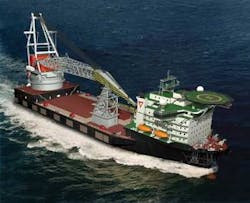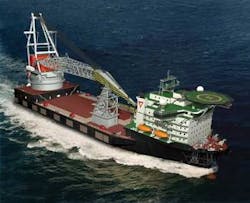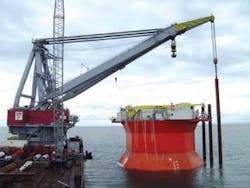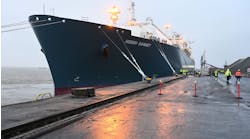Jeremy Beckman, Editor, Europe
North Sea platform construction has tailed off over recent years, causing Seaway Heavy Lifting to shift its focus. Currently, it is more active in the Mediterranean, Middle East, and India, but in 2010, it aims to go global.
The vehicle for this campaign is theOleg Strashnov, a heavy-lift monohull crane vessel under construction at the Merwede Shipyard, close to Rotterdam.
Artist’s impression of theOleg Strashnov with the boom lowered.
“Their price was more expensive than what you might expect from a Far East yard, but we were more confident in the quality of their work, and their ability to deliver the vessel on time,” says Aart Ligterink, Seaway’s business development manager. “After the sea trials, we aim to go straight to an offshore project in 2010.”
TheOleg Strashnov will be capable of 5,000-metric-ton (5,511-ton) single lifts, either on anchors or in dynamic positioning mode, and its novel hull shape should allow it to reach transit speeds of up to 14 knots. This is 5 knots faster than Seaway Heavy Lifting’s existing crane vessel, the Stanislav Yudin, already one of the fastest construction vessels around, according to Ligterink. At that pace, the new vessel could transfer swiftly between far-flung locations, allowing Seaway Heavy Lifting to pitch for mid-size installation jobs anywhere in the world.
The concept had been on the drawing-board for some time before Gusto MSC started conceptual engineering studies in mid-2005. Seaway Heavy Lifting contracted Wartsila for the engines and propulsion equipment in summer 2006, but only awarded the main vessel construction contract this spring.
“We took our time about going out to tender,” Ligterink says, “because we wanted a good handle on what we needed to order to ensure that the vessel had the highest quality equipment and a more reliable delivery date and end price. We also commissioned model tests with Marin in Holland to verify the vessel’s speed and dynamic behavior, and the results confirmed our computer model.”
Investment timing was driven by market trends, he adds. “What we saw was that the environment was becoming more and more important in terms of limiting gas flaring, CO2 emissions and so on, resulting in heavier topsides. Also, the operators were looking to develop more complicated fields in new production areas more remote from the traditional energy provinces. Both those factors were creating a need for more processing equipment on platforms. At the same time, offshore hook-up was becoming very, very expensive, with a lack of specialist labor complicating matters for fabricators.
“If, however, a vessel were available for 5,000 metric ton (5,511 ton) lifts - below the normal volume range of the largest crane barges - we felt this could be a great advantage for companies looking to develop isolated fields in remote areas like, for example, the Mediterranean, Southeast Asia, Australia, and eastern Canada. It could be done economically, provided the vessel had a very high transit speed.”
Seaway claims this will be achieved by means of the patented hull-shape. The vessel will be 183 m (600 ft) long, with a breadth of 47 m (154 ft), and a draught varying from 8.5 m (27.9 ft) while in transit up to 13.5 m (44.3 ft) on location.
Its fully revolving offshore crane, also designed by Gusto MSC, will be equipped for lift heights of 100 m (328 ft) for the 5,000 metric ton (5,511 ton) main hook, and 132 m (433 ft) for the 800 metric ton (882 ton) auxiliary hook. This represents the highest hook heights attainable for monohull crane vessels and will facilitate a range of tasks, from dual hook upending of large jackets to heavy deck installations and deepwater templates, as well as smaller modules at high platform elevations, the company says.
Power will be provided by six 4.5 MW main engines, with two 5 MW azimuthing underwater aft propulsion thrusters, two 3.5 MW azimuthing DP thrusters amidships, and two 1 MW bow thrusters. The Kongsberg DP-3 system will ease the installation of heavy topsides and deepwater structures such as templates, TLP/spar foundations, as well as the more traditional lifts in infrastructure-congested fields. The eight-point mooring system comprises 2,200 m (7,218 ft) long mooring wires and 15 metric ton (16.54 ton) Delta Flipper anchors.
At peak periods, the vessel will be able to accommodate 395 personnel. Although it is being offered primarily as a heavy lift vessel, space also has been left for an underdeck firing line, with the capability to accommodate heavy J-lay equipment.
TheOleg Strashnov will have a design life of 40 years, and Seaway Heavy Lifting is looking for payback on its investment within a reasonable time, Ligterink says. Market reception so far looks promising, he adds. “We have had already quite a lot of attention from oil companies, both IOCs and NOCs, about its availability,” Ligterink says.
In preparation for the new vessel, Seaway Heavy Lifting has been stepping up recruitment. Staff numbers at headquarters in Zoetermeer, close to The Hague, have increased, with increasing numbers set to be hired over the next 18 months. The company is on the look-out in particular for project managers, project engineers and structural engineers. “Ultimately,” says Ligterink, “we will grow to around 150 office staff when we have the new vessel in operation.
“Over the last few years, this has been a company where people were strongly focused on working closely together to get the job done in an informal environment and thus creating an excellent atmosphere. We have a very low turnover of staff, and our people are highly motivated. They have had opportunities in recent years to work in the Middle East, Mediterranean, India, as well as the North Sea, and that stimulation keeps the work and the company attractive for them.”
In August 2007, theStanislav Yudin performed its second job for Lukoil in the far north of Russia, installing the base of a fixed offshore ice-resistant off-loading terminal (Foirot) in the Barents Sea, 22 km (13.68 mi) offshore Varandey. This has been designed to accommodate 70,000 dwt ice-breaking tankers.
Installation this summer of the 24 skirt piles for the Varandey Foirot base in the Russian arctic.
The Foirot, built at the OOO Lukoil-Kaliningradmorneft steelworks, is a 50 m (164 ft) tall, 11,000 ton (9,979 metric ton) structure comprising a base leg, an accommodation module, a mooring cargo handling system (MCHS) with a jib, and a helicopter pad. Oil produced onshore in the north of the Nenets Autonomous District will be exported to the Foirot from storage tanks in Varandey through two new subsea pipelines. When the facility enters service later this year, it will be the first marine oil export system in the Russian arctic.
Seaway Heavy Lifting mobilized theStanislav Yudin from Rotterdam to the offshore location at the end of July to be ready for the start of the three-month ice-free period in this region. The Foirot itself was shipped in sections via two transport barges, the 10,000 ton (9,071 metric ton) base and 1,450 ton (1,315 metric ton) MCHS being under SHL’s management. “The installation was completed in 17 days,” says Ligterink, “exactly as planned. This was crucial with respect to the ice threat.”
In October, theStanislav Yudin started mobilization to India for ONGC’s BCP-B2 booster compression platform in the Arabian Sea, under sub-contract to Indian fabricator Larsen & Toubro. Thereafter, the vessel will install two heavy decks for IOEC’s South Pars 9 and 10 gas field projects. Its next assignment in this sector will be four wellhead platforms for the Heera field development of ONGC in Feb.-March 2008, under sub-contract to New Delhi-based construction group Punj Lloyd.
Seaway Heavy Lifting also has been selected to install different packages of the Maersk Al Shaheen oil development project off Qatar in 2008 and 2009. “This is the big difference I see in the market,” says Ligterink. “In the past, we always tendered for installation projects for the coming year. Now oil companies are seeing the world-wide shortage of specialist vessels, and are contracting jobs at a much earlier stage in their programs.”
In spring 2006, the vessel installed BG’s Panna PH, PJ, and Tapti SPD platforms offshore India, followed this spring by the TCPP and MTA platforms for the same company under the NRPOD project.
Western India is becoming increasingly important for theStanislav Yudin. All offshore activities have to be staged between October and mid-May, before the monsoon season. This requires tight project planning and execution, both for Seaway Heavy Lifting and the local operators, says Ligterink.
“One of our strengths is that we are not linked to a specific fabricator, which means we can offer our services as an independent contractor to the entire industry, as we do with theStanislav Yudin. We are aiming for lump-sum contracts. This should be a benefit for both the main contractor and the operator, as it limits the investment risk.
“India needs a large number of platforms to be installed each year to fuel its energy requirements. Quite a number of these structures are being fabricated in India, where the yards are very professional, building the structures, loading them onto cargo barges for transfer directly to the offshore location. For that approach to work though, you need to carefully optimize the crane vessel’s installation schedule.”
In general, while India’s offshore structures are much taller than their equivalents in the southern North Sea, the weights are in the same order of magnitude - typically, he says, 800-1,400 metric tons (882-1,543 tons) jackets with topsides up to 2,300 metric tons (2,535 tons), for average water depths of 60-80 m (197-262 ft).
“The really big difference is that in the North Sea, vertical skirt piles are commonly used as soil strength allows relatively shallow penetrations and consequently, piles are of modest length. However, in India, to overcome the relative soft soil layers near the seabed, the jackets have long battered skirt piles and have to be driven with followers, which is more time-consuming.
“The reason for applying battered skirt piles instead of vertical skirt piles is the uncertainty over soil conditions. The Bombay High field piles could refuse due to unexpectedly hard seabed layers. Cemented layers may be encountered that are not always revealed during soil investigations.
“ONGC recognizes this problem, and therefore insists on inclined skirt piles which are easier to drill out. But drilling out piles is a time-consuming operation that can take days to complete. For piling we would use our own hammers, ranging from the IHC S-500 up to the IHC S-1800, which can drive piles of up to 84 in. (213 cm) outside diameter directly or larger when a follower with transition is used.”
For 2008, Ligterink concludes, “it is unlikely that we are going back to the North Sea as there is hardly any work there, although we are still investigating options with some clients.”





